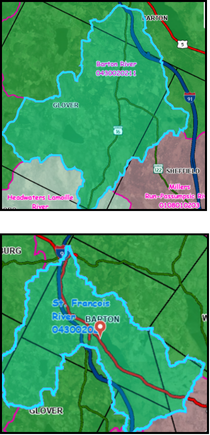"Slow the Flow" Local Fund Pool

FY2026 Orleans County NRCS Local Fund Pool - Slow to Flow to address High Flows in the Upper Barton River to Improve Water Quality
In the winter of 2025, the Orleans County Natural Resources Conservation District conducted surveys and hosted three Local Work Group (LWG) in-person meetings. LWG participants concluded that addressing effects of high flows is one of the priorities for a local fund pool.
The priority concern for this Local Fund Pool is to address water quality degradation from increased flooding and the subsequent erosion and sedimentation that occurs. This Local Fund Pool is called “Slow the Flow,” and it will provide funding to landowners for projects that stabilize headwater areas in the Upper Barton River watersheds. Potential conservation projects include strategic placements of woody material, stream habitat improvement and management, beaver dam analogues and/or post-assisted log structures, streambank and shoreline protection, and channel bed stabilization.
Application Due Date: Friday August 22nd
Problem Statement/Need Based on LWG Feedback:
- Water Quality Degradation: Streams, rivers, lakes, and ponds in Orleans County are experiencing degraded water quality due to increased rain fall, agricultural runoff, inadequate buffers, petrochemical and sediment runoff from roads and forests.
- Increased Flooding and Erosion: Increased rainfall from climate change is intensifying erosion in the headwaters and flooding in the valleys, exacerbated by traditional channel, riparian and forest management, outdated infrastructure and inadequate floodplain management.
- Sedimentation and High Water Flow: These issues are damaging aquatic habitats, infrastructure, and disrupting natural hydrology.
Key Concerns: Include impactful infrastructure (culverts), concentrated flow paths with head cuts, tributary and ditch bank erosion and head cuts headwaters area.
Work with partners like MWA, TNC, NEKO and VHCB to stabilize headwater areas in the Upper Barton River Watershed to achieve cleaner water, reduce pollution, improve runoff management, enhance habitats, increase flood resilience, and foster collaboration.
- Install conservation practices on at least six landowners' properties with 200 acres or more.
- Restore streams and riparian areas by at least 2,500 linear feet.
- Through landowner collaboration and available funding obligate 1-2 projects per year.
Project Area Focus: Orleans County, Vermont, specifically within the Barton River Watershed.
Scale: Approximately 50,000 acres approx. 11% of the county acreage.
5 Core conservation practices available:
- Stream Habitat Improvement and Management (395): Improve and manage stream habitat by addressing factors impairing function and structure.
- Channel bed stabilization (584): Maintain or alter channel bed elevation or gradient.
- Vegetative Barrier (601): Reduce sheet and rill erosion • Reduce ephemeral gully erosion • Reduce sediment transport to surface waters.
- Streambank and Shoreline Protection (580): To prevent land loss, reduce sediment, and improve habitat.
- Beaver Dam Analogues (BDAs) and/or Post-Assisted Log Structures (PALS): mimic, promote, and sustain the natural processes of beaver dam activity and wood accumulation that lead to more fully connected floodplains.
28 additional practices are available to support these main practices
Brief timeline of implementation:
- Summer and Fall 2025:Outreach and engagement with landowners. MWA & OCNRCD, VTFWD funded, stream assessments and shared outreach. Focus on two HUC 12 watersheds in Glover and Barton.
- By December 2025: Assist at least 4 landowners with assessments and conservation practice planning.
- By May 2026: Develop and provide project management services for to implement 1-2 local fund pool conservation plans.
- Ongoing (3-5 years and potentially beyond): Project implementation continues and OCNRCD continues to work with NRCS to maintain funding for this priority.
Available Funding in federal FY 2026: $200,000
Project Ranking Priorities
- Is the application addressing erosion caused by concentrated high flows?
- Is the application in the Upper Barton River priority HUC 12?
- Does this application include more than three practices?
- Does the applicant own 200 acres or more ?
- Is the applicant new to NRCS?
- Is the applicant addressing more that one erosive location?
- Does the application produce improved stream stability?
- Is the application addressing sedimentation to headwater streams?
- Does the application address the impacts of private land infrastructure?
- Does the application include more than one of the five core practices?
Applicants DO NOT need to answer yes to all of the Project Ranking Priorities to apply. However, the more priorities that are addressed, the more likely the application will be selected for funding.
NRCS Application - CPA_1200_V10.2024.pdf